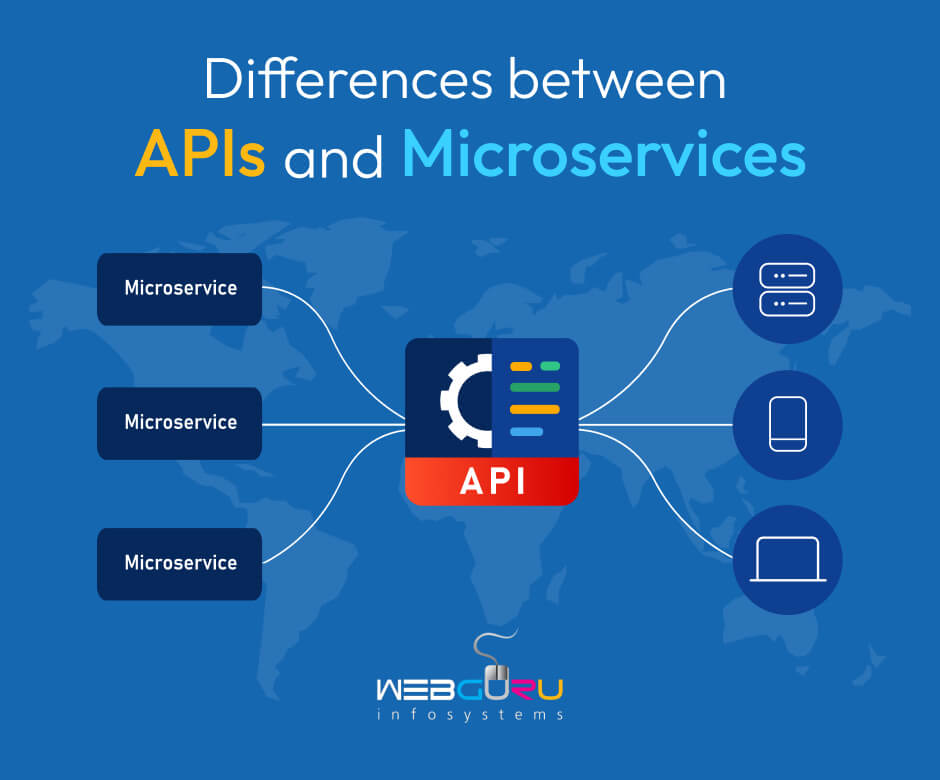Home Blog Web Application Development APIs and Microservices – What Are They?
APIs and Microservices – What Are They?
- 27 Oct / 2022
- 5,989 views
- 5 Min Read

API and Microservice – these are two new buzzwords of the tech industry, both very important in modern day web application development. However, even though their uses often overlap, these terms cannot be used interchangeably. It is important to understand what they mean, and how they are different from one another.
What is an API
API (application programming interface) is a set of rules and protocols that allow software to communicate with other software. It allows developers to create applications that interact with outside services or systems, without having to learn the codebaseof those systems. APIs can be used for a variety of purposes, such as retrieving data from an external service, sending requests to webhooks in order to trigger actions within another system, or even controlling devices remotely.
Typically, APIs handle data by fielding HTTP requests and returning responses in JSON format. There are several kinds of APIs such as REST, GraphQL, SOAP, gRPC, and more. REST (REpresentational State Transfer) APIs are generally used for security and efficiency.
Read More: Best Practices for Building RESTful APIs for Mobile Apps
Why Use APIs
A big reason why businesses use APIs is that they offer a way for users to access internal systems and data without needing any developer skillset. This makes it much easier for them to integrate new features into their applications or increase the accessibility and usability of their existing ones.
There are several reasons why an API might be desirable:
- It could provide greater flexibility by allowing users to interact with services through different channels (such as web browsers, mobile apps, etc.).
- An API could enable more efficient data management and analysis by giving external parties access to platform data stores without needing their own proprietary software modules or engines.
- It could speed up the development process by making it easy for programmers to develop plugins or extensions for existing applications without having to start from scratch.
What is a Microservice
Web microservices are small, modular pieces of software that can be used to improve the performance and reliability of a website. “Microservice” actually refers to a style of architecture. Simply put, web microservices help developers break down their applications into smaller, more manageable pieces so that they can address specific problems and issues faster. This makes it easier for them to test new ideas or modifications without affecting the whole site – something that is often difficult or impossible to do with traditional web architecture designs.
One big reason why web microservices are gaining popularity is that they enable companies to scale their businesses independently from one another. This means that even if one part of a company’s business suffers (for example, due to low traffic), other parts of the company can still remain operational thanks to the web microservice concept. The problems this can typically solve are:
- Poor response time for high-volume websites
- Difficulty managing large volumes of data on legacy systems
- Issues with scalability.
Why Use Microservices
A web microservice is a small, self-contained application that can be deployed on the internet as a service. This means that it can be accessed by other applications and systems over the network, rather than being physically installed on a machine. Web microservices are often used in eCommerce businesses because they allow companies to scale their operations quickly and easily. They also make it easy to create modularized solutions, which makes it easier to change or improve an existing system without having to rebuild it from scratch.
There are several reasons why businesses might want to use web microservices:
- They allow for rapid deployment of new features or improvements.
- They enable companies to create isolated systems that operate independently but share a common code base(s). This allows for easier testing and debugging of individual components.
- Web microservices provide scalability and performance advantages over traditional monolithic applications. Because they’re designed with multitenancy in mind, they can handle increased demand without suffering from performance issues or data loss issues caused by overcrowding.
APIs and Microservices – Are They Interchangeable?
Microservices and APIs are frequently paired together, and there’s a good reason for it. Just like how web applications and software use open APIs to communicate with each other, microservices too (as well as services within microservices) use internal or private APIs toaccess each other’s components. However, these APIs are specific to each service that uses them. No two microservices are alike within a system, and use APIs in their own way.
The primary differences between APIs and microservices may be summed up as follows.
An API
- Is a framework.
- Is what an application uses to communicate with other applications.
- Defines what an acceptable request is and what the response should be.
On the other hand, a microservice
- Is an architectural style.
- Is how an application is broken down into smaller, self-contained “mini-applications”.
- Makes maintaining and scaling software (or parts of it) easier.
Finally, it is important to note that APIs have a role within as well as beyond microservices.
Conclusion
Several leading software companies across the world have begun to shift towards a microservice model, including Uber, Netflix, Etsy, Amazon, and Spotify. However, the appeal of APIs to enterprises is primarily that, apart from enabling communication between microservices themselves, they can also lead the way for powerful third-party integrations. This essentially makes APIs a business model, where they are sold as products.
8 comments
Leave a Reply

-
1000+
Happy
Clients -
25+
Countries
Served -
19+
Years of
Trust









Although both API and microservice are important in modern-day web application development, people often get confused between these two terms. However, the blog highlights some of the major differences between these two terms to help us understand what they both entail. Great read.
While Microservices is an architectural style, the programming interface is the immediate impact of applying that style to your application. Also, APIs are a way to understand miniature administrations.
The blog nicely explains about Programming interface and Microservices.
Microservices architecture is an architectural style that structures an application as a collection of small, self-contained services. Application Program Interface (API) is the part of an application that communicates with other applications to process the client’s request. The blog has explained well about APIs and Microservices.
Microservices have become the go-to architecture for businesses to develop software solutions and are a departure from using monolithic architecture. The blog has expounded well on differentiating API and microservices. Kudos.
We thank you for liking our blog post about the differences explained between API and Microservices.
Microservices are a type of software architecture that divides different functions of an application into smaller components. An API is a part of an application that communicates with other applications. APIs are necessary for the digital infrastructure because they enable standardized and efficient communication between applications, which might differ in function and construction.
Wonderful web site. Lots of helpful info here. I am sending it to several friends and also sharing in delicious.
Educational Blog. incredibly helpful!